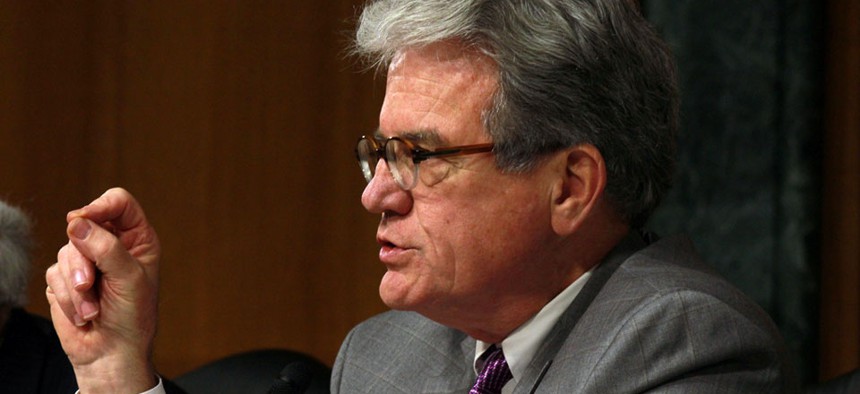
“When Wal-Mart buys, I guarantee they get the best price, and when Honeywell buys, they get the best price,” said ranking member Sen. Tom Coburn, R-Okla. Flickr user talkradionews
Government Should Leverage Its Size to Get Better Prices, Senators Say
OMB, GSA told to measure strategic sourcing progress.
The seven-year-old effort by agency buyers to achieve private-sector levels of strategic sourcing has shown only modest progress, a Senate panel was told on Monday, due to managers’ fears of losing control of budgets, a lack of incentives and vague performance metrics.
The push to increase efficiency by bulk buying office products, printing and increasingly sophisticated services has brought only a 5 percent participation rate in contracts governmentwide, compared with as much as 90 percent at such companies as Pfizer, Delphi and Dell, according to witnesses at a hearing by the Senate Homeland Security and Governmental Affairs Committee.
“When Wal-Mart buys, I guarantee they get the best price, and when Honeywell buys, they get the best price,” said ranking member Sen. Tom Coburn, R-Okla. Coburn said he’d personally persuaded large contractors such as Lockheed Martin and General Electric to give discounts on major Defense Department contracts, “simply because no one at the Pentagon had asked.”
Chairman Tom Carper, D-Del., called the Obama administration’s key procurement officers to respond to Government Accountability Office reports showing that the top four purchasing departments -- Defense, Energy, Homeland Security and Veterans Affairs -- were achieving only 5 percent of contracts using strategic sourcing’s careful analysis of spending needs and markets and rigorous monitoring of vendor prices. “Federal agencies appear to behave more like medium-sized, unrelated businesses than the largest purchaser in the world -- which is what the U.S. government is,” Carper said.
He placed strategic sourcing’s potential savings -- up to $80 billion annually-- in the context of President Obama’s recent announcement of a new management initiative led by Budget Director Sylvia Burwell, who came from the Wal-Mart Foundation.
A defense of progress to date came from Joe Jordan, administrator of the White House Office of Federal Procurement Policy, who said OMB’s interagency Strategic Sourcing Leadership Council, convened last December, has “challenged agencies to save billions through structural contracting practices” such as continuous price monitoring and usage data, so that “program managers can focus on more mission-critical contracts.”
The obstacles include “a decentralized process with a lack of visibility into what other agencies do,” Jordan said. But he cited progress in reducing what once was 4,000 separate wireless phone agreements with 800 plans to one contract vehicle, the saving of $600 million through shared contracts for janitorial services, and the General Services Administration’s office supplies contracts that have upped the rate of small business participation from 67 percent to 76 percent.
“As we move forward, I am confident the savings will ramp up over time,” Jordan said, citing a goal of $100 billion as the “addressable spend.”
Dan Tangherlini, newly confirmed as administrator of GSA, said strategic sourcing in 20 agencies has saved $300 million since 2010. He said his agency is preparing 10 new strategic sourcing contracts to that could save “hundreds of millions” by showing agencies data on the savings many are “leaving on the table” by not using for example, the GSA schedules, which are “50 percent faster” in such areas as domestic shipping, office supplies and print management.
“Contractors are required to report transactional data on all program sales,” he said. “For the first time, this level of financial information collection provides us with a clear picture of agency spending behavior. Over the last several months, GSA has used this data to show contractors their pricing item by item, compared with their competitors in an anonymous fashion. This has empowered contractors to understand their competitive position, and in many cases offer better deals.”
A less hopeful characterization came from Christina Champlain, GAO’s director of acquisition and sourcing management, who testified that the program -- when compared with her studies and visits with private companies -- “had only managed a small amount of spending through its four governmentwide strategic sourcing initiatives in fiscal year 2011, although it reported achieving significant savings on those efforts. Further, we found that most selected agencies' efforts did not address their highest spending areas, such as services, which may provide opportunities for significant savings.”
The department making the most progress, Champlain said, was Homeland Security.
Resistance, she added, comes from “negative incentives”—managers don’t want their budgets cut, and fear losing control over spending. What is needed is more leadership and greater congressional oversight, she said, to keep the pressure on agencies to exploit opportunities.
Coburn charged that OMB has insufficient guidance and performance metrics. “An absence of guidelines means you don’t know if the data are right—it’s one of the problems with government,” he said.
Jordan responded that the methodologies being developed by specialty teams on the interagency council are complex because “the drivers of costs differ from the drivers of savings.” While agencies do need to be challenged to better gauge savings, “we have addressed a number of those issues,” he said, noting that GAO recently removed interagency contracting from its high-risk list.
NEXT STORY: 7 Ways to Better Manage a Slacker







